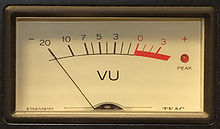vu meter
A vu meter (vu stands for English volume units , roughly "volume units") is a VU , so a measuring instrument for assessing the modulation in the sound equipment . Standardized in accordance with DIN IEC 60268-17, it shows the rectified value and is called the Standard Volume Indicator (SVI) .
In addition to the vu meter, the device is also called a VU meter or volume indicator (VI).
history
The vu-Meter was originally developed by Bell Telephone Laboratories in order to make it easier to adjust the power of telephone transmission via cable using an easy-to-read measuring instrument . In 1961, the specifications were recorded in the standard ANSI C16.5-1961 (prepared by Bell Telephone Laboratories, Columbia Broadcasting Systems (CBS), National Broadcasting Company (NBC)). Vu is "a quantitative expression of the signal size in an electrical circuit" (DIN IEC 60268 Part 17).
Usage today
Today's level displays are mostly built with LEDs or VFD and work like a bar display with a peak value indicator. The bar graph shows the current level, while a single LED stores the peak value and then only slowly goes back. In this way, two pieces of information are given: the current level, which fluctuates depending on the music, and the level peak that occurred a few seconds ago. They are mainly used in professional audio technology, for example in recording studios . They can also run as software on the control computer screen.
While devices with vu meters were also widespread in the private sector up to the 2000s due to the need to control the recording level required for hi-fi cassette decks , they are rarely found today in the amateur sector with MP3 storage technology for storing music.
construction
The vu-meter is historically a moving coil mechanism with an upstream full wave rectifier and largely linear display. The main scale shows the logarithmic size vu from −20 vu to +3 vu. In addition, percentages are usually given. 0 vu corresponds to 100%.
The vu meter measures the rectified value , usually with a slight tendency towards the effective value. A change of one vu corresponds to a change of one dB .
Characteristic
The settling time ( integration time ) required by the vu meter to achieve 99% of the reference display 0 vu with a 1 kHz sine wave signal of 0 vu must be 300 ms ± 10%. The overshoot of the pointer must be between 1% and 1.5%. The ramp-down time after switching off the test signal should equal the settling time. This ballistics produces a display characteristic which roughly approximates the hearing sensitivity of the human ear .
According to the standard, the deviation between 35 Hz and 16 kHz with a constant voltage of the sinusoidal signal compared to the reference display (a sinusoidal signal of 1 kHz) must be less than 0.5 vu.
restrictions
The vu-meter has a high degree of inertia and does not react to short-term peak values. This type of display could therefore not establish itself in Europe. From a technical point of view, it is considered insufficient that short level peaks are not recognized and displayed and there is a risk that the signal is recorded with distortions. In order to be warned of such overloads , the measuring device is given a so-called lead time; english lead . These settings are empirical values or result from metrological conditions. In HiFi devices, the preroll is often linked to the DOLBY level and is different for each type of tape. Often 6 dB is mentioned, but this is not actually the case in studio technology or in the consumer sector. The sound engineer must note that a vu meter with a forward signal indicates continuous signals with a correspondingly higher level. This must be taken into account when performing calibration work. At " full level " with sine the pointer hits the top.
In Europe, devices that respond much faster to dynamic signals have established themselves in professional sound engineering. These are level meters such as the Peak Program Meter (PPM / quasi-peak level meter ) and the SPPM, which show the (quasi) peak value in terms of time ( integration time ) and form ( form factor ) . There are “real peak value displays” for digital sound technology, see dBFS .

